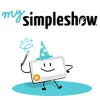Take a look inside 5 images
mysimpleshow
Pros: Useful ability to add student drawings and graphics, lots of guidance for creating videos.
Cons: Videos are all essentially delivered the same way; the free version is limited, paid version is pricey.
Bottom Line: While quick and easy, these explainer presentations will best demonstrate learning if students upload their own graphics.
Teachers could use mysimpleshow to introduce a new subject through an engaging presentation. Students could use it to demonstrate learning in any content area. There are a number of educational templates, such as summarizing literature, summarizing a famous person's biography, explaining a mathematical concept, and introducing a physical law. Each template is completely customizable, but students can start with a blank one, as well. Mysimpleshow is aptly named, as creating a presentation can be completed quickly and easily; if students have pre-written text, they could create a quality presentation in under 15 minutes.
There's an option to upload your own graphics, which would strengthen the connection between the presentation and the demonstrated learning. Students could draw a diagram of a frog or a portrait of a historical figure and upload a photo of it. If a student created a great graph on the computer, the student could take a screenshot of it and include it in the mysimpleshow presentation, as well. Students need to sign up with email, which means they'll need to be at least 13 years old. For younger students, teachers will need to have them sign in through their email or create one for them. Also, with the free version, all created videos are made publicly available.
With mysimpleshow, students and teachers create explainer presentations through a web-based platform. The tool automatically breaks student or teacher writing into a series of slides and analyzes it for keywords. Then, mysimpleshow selects and places simple black and white graphics. Students can change the placement of the graphics, as well as select a different graphic or substitute their own. There's also a handy option to import a PowerPoint file, where mysimpleshow breaks out the text from the slides and selects graphics to go along with the text.
Finalizing the video is where the differences between the free and paid versions are apparent. The free version has one male computerized voice that will read the presentation. Choosing a different voice or recording your own is only available in the paid version. A paid version is also required if you want to download the movie -- with the free version, you're restricted to sharing a link.
The main draw of mysimpleshow is the popular effect where a realistic hand slides drawings in and out as the presentation is being read aloud. While this is initially engaging, it could get old after a few presentations. Each phase of the process is explained by a brief video, which is a good support to help students and teachers along. During the writing phase of mysimpleshow, there are helpful examples from other presentations off to the side, which is great for students who find organizing information challenging. The bulk of the writing happens in the Story section, which is limited to 1200 characters, so students will have to carefully consider the information they put in their presentation.
There are some equity concerns with the free version. The only voice provided to read text is a male voice -- there should be a female option, as well. Also, subtitles are not available in the free version, making videos inaccessible for people with hearing loss. Both features are available in the paid version.














